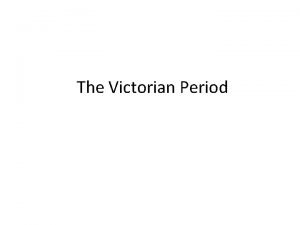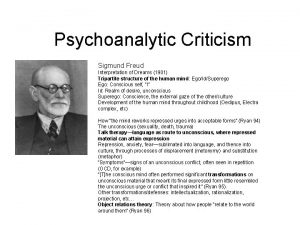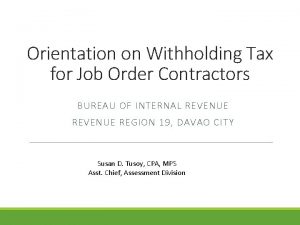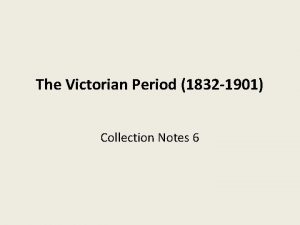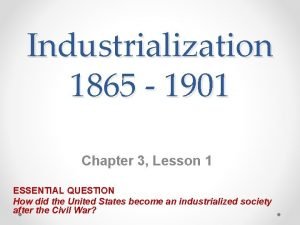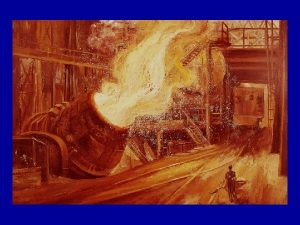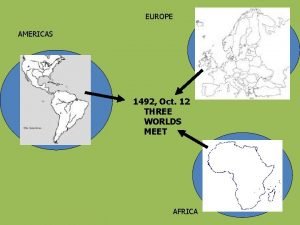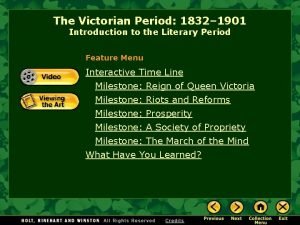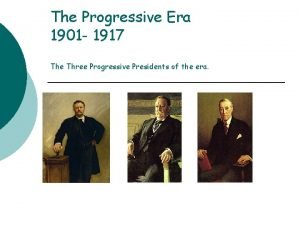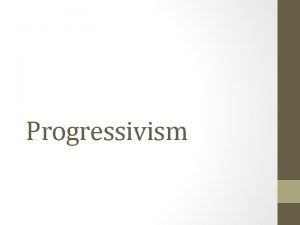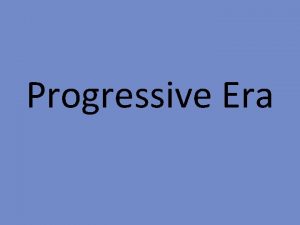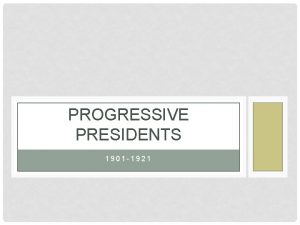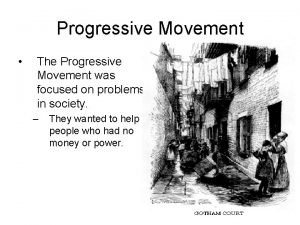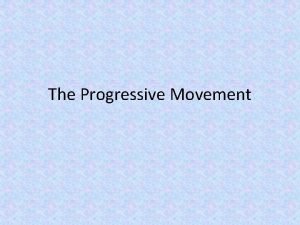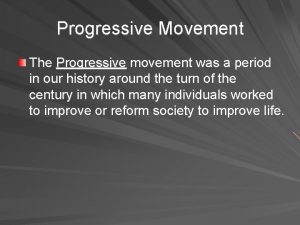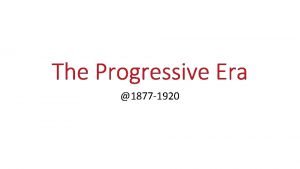The Progressive Era 1901 1917 The Progressive Movement













- Slides: 13

The Progressive Era, 1901 -1917

The Progressive Movement: Definition and Character Ú Goals – Political - Revitalize American Democracy • Make government responsive to people not special interests or bosses – Economic - Restore equity and opportunity to American capitalism – Social - Provide social justice to the poor Ú Progressive Philosophy – Did not believe in radical change (socialism) – But wanted fair competition and worker regulation Ú Operated on all levels of government Ú Included both democrats and republicans.

Composition Ú Middle Class White Americans Ú Farmers and Small Businessmen Ú Social Reformers Ú Professors & Lawyers Ú Not included: Racial Minorities, new immigrants, Labor Unions

Middle Class White Americans Ú Wanted to restore honesty and integrity to government – They wanted to end corruption at all levels. • Elimination of political machines • Institute civil service reforms – End special interest lobbyist in legislative bodies

Farmers and Small Business Ú People who wanted to use the government to regulate the abuses of corporations and trusts – Wanted trusts eliminated – Wanted government controlled railroads rates and banks – Currency reform Ú Had some success – but not enforced – Republicans embraced laissez-faire economics – Interstate Commerce Act – Sherman Anti-Trust Act

Social Reformers Ú Government should alleviate social problems – Slums and tenements Ú Unsafe working conditions & child labor Ú Treatment of new immigrants Ú Some small scale success – Jane Addams (Hull House – Chicago)

Included Professors, Lawyers and Social Gospel Advocates Ú The industrial revolution brought on the need for corporate lawyers – Law was once a respected profession – Paid well to defend the interests of their company – Lawyers felt they were losing there identity Ú Intellectuals – Use University professors to make the society more efficient – Wealthy men – donate to Universities • in return - donor had expectations for curriculum – Many intellectuals were concerned about this

What Really Got Progressivism Moving? Ú Teddy Roosevelt’s Assumption of the Presidency in 1901 – William Mc. Kinley is assassinated in Sept. 1901 – Youngest president at 43 years old – Gradually provided a national focus on Progressivism Ú Rise of the ‘ Muckrakers”

Muckrakers Ú “Investigative journalism” Ú Sensationalized Exposes on corporation corruption – Raised awareness Ú Magazines – Mc. Clure’s, Cosmopolitan Ú Ida Tarbell (1902) does and expose in Mc. Clure’s on Standard Oil – Illegal Monopoly Ú Novels – The Octopus by Frank Norris – The Jungle by Upton Sinclair – How the Other Half Lives - Jacob Riis Ú The Muckrakers formula is… – Uncover a scandal – Attack it using facts to back up arguments – Has a tremendous impact on readers

Achievements of Progressivism Ú Many political machines are overthrown – The Shame of the Cities – Lincoln Steffens – said political machines serve their own interests and that of corporations, not the people – Thomas Nast Ú Leader of Progressive reform is Wisconsin 1900 -01 – Robert La. Follette – Reduce gov’t corruption: Institutes the referendum, recall, primaries – Corrupt political practices acts passed – controls on campaign spending and lobbying – The universities must aid the state economists - come up with an effective tax system, highway system. – Child Labor Laws (one of the first states) – Building codes & controlled hours

Thomas Nast & Harper’s Weekly

Amendments to the Constitution Ú The 16 th Amendment – 1913 – Constitutional for the government to impose a personal income tax. Ú The 17 th Amendment – 1913 – Senators must be directly elected in a popular election. Ú The 18 th Amendment – Jan 1919 – Prohibition – Illegal to buy, sell or distribute hard spirits in the US. Ú The 19 th Amendment – 1920 – Prohibited states from denying women the right to vote. • Women did vote in certain states prior to this (In NJ in the late 1700 s for a short time. • Also, some western states allowed women to vote)

Contradictions of Progressivism Ú Generally oppose political and social equality for racial minorities and recent immigrants Ú Many Progressives Oppose Women’s Suffrage – Woodrow Wilson was one of these guys. He felt it was a state, not a national issue. Ú Many Progressives Oppose National Labor Unions – Concerned about the plight of the working man, but at the same time opposed unions – Fear of Marxism – union leadership advocated changes that were too radical – Fear of radical uprisings Ú Many Progressives Support Tighter Immigration Restrictions
 Agosto 13 1898
Agosto 13 1898 Poblogaeth cymru 1901
Poblogaeth cymru 1901 Ceremoniality
Ceremoniality Numberblocks 1901
Numberblocks 1901 Freud 1901
Freud 1901 Withholding tax contractors
Withholding tax contractors 1837-1901
1837-1901 Victorian age 1832 to 1901
Victorian age 1832 to 1901 Chapter 3 lesson 1 the rise of industry answers
Chapter 3 lesson 1 the rise of industry answers 1901 n. moore street
1901 n. moore street Victorian age
Victorian age Industrialization (1865 to 1901 worksheet answers key)
Industrialization (1865 to 1901 worksheet answers key) British empire 1901
British empire 1901 The victorian period (1832–1901)
The victorian period (1832–1901)


